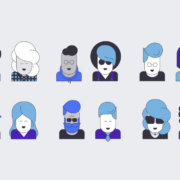Technology Vision 2024
Human by design
15-MINUTE READ JANUARY 09, 2024
In brief
Technology is becoming human by design, and enterprises that prepare now will win in the future.
How people access and interact with information is radically changing as human-like, AI-powered chatbots synthesize vast amounts of information and provide answers and advice.
AI is starting to reason like us, and will soon comprise entire ecosystems of AI agents who will work with one another and act for people and organizations alike.
A new spatial computing medium is emerging, letting the digital world reflect what it means to be human and in a physical space.
The challenge of tech not understanding us and our intent is disappearing: machines are getting much better at interacting with humans on their level.
Read the report
Read the executive summary
Human by design: How AI unleashes the next level of human potential
It’s time to make technology human by design.
This is a moment for reinvention. In the coming years, businesses will have an increasingly powerful array of technologies at their disposal that will open new pathways to unleash greater human potential, productivity, and creativity. Early adopters and leading businesses have kick-started a race toward a new era of value and capability. And their strategies are underpinned by one common thread – the technology is becoming more human.
It sounds counterintuitive: after all, wasn’t technology built by, and for, humans? Creating tools that expand our physical and cognitive abilities is so unique to humanity that some argue it defines us as a species.
Despite this, the tools we build are often distinctly unhuman, filling gaps by doing and being what we couldn’t, and in the process radically transforming our lives. Automobiles expanded our freedom of mobility. Cranes let us build skyscrapers and bridges. Machines helped us create, distribute, and listen to music.
Technology’s unhuman nature can also be its drawback. Extended use of hand tools can lead to arthritis. Years of looking at screens can accelerate vision problems. We have amazing navigational tools, but they still distract us from driving. Granted, there have been efforts to create tools that are more ergonomic or easier to use. But even so, time and again we see and make decisions about our lives based on what is best for a machine rather than optimizing human potential.
Now, for the first time in history, there’s strong evidence to indicate that we are reversing course—not by moving away from technology, but rather by embracing a generation of technology that is more human. Technology that is more intuitive, both in design and its very nature, demonstrates more human-like intelligence, and is easy to integrate across every aspect of our lives.
Generative AI has the potential to impact much more than just the task at hand. It’s also starting to profoundly reshape organizations and markets.
Consider the impact generative AI and transformer models are having on the world around us. What began as chatbots like ChatGPT and Bard has become a driving force in making technology more intuitive, intelligent and accessible to all. Where AI once focused on automation and routine tasks, it’s now shifting to augmentation, changing how people approach work, and is rapidly democratizing the technologies and specialized knowledge work that were once reserved for the highly trained or deep pocketed.
Generative AI has the potential to impact much more than just the task at hand. It’s also starting to profoundly reshape organizations and markets.
Of course, the advent of more human technology isn’t limited to AI: It’s starting to address many of the pain points that exist between us and technology, paving the way for greater human potential.
Technology that is human by design will reach new people and expand access to knowledge, which will enable ongoing innovation. Think of all the people historically alienated by technology who will be able to contribute to the digital revolution. As technology becomes more intuitive, we can tap into these people as new customers and new employees.
Make It Human—the 2024 Trends
A match made in AI
People are asking generative AI chatbots for information – transforming the business of search today, and the futures of software and data-driven enterprises tomorrow.
Meet my agent
AI is taking action, and soon whole ecosystems of AI agents could command major aspects of business. Appropriate human guidance and oversight is critical.
The space we need
The spatial computing technology landscape is rapidly growing, but to successfully capitalize on this new medium, enterprises will need to find its killer apps.
Our bodies electronic
A suite of technologies – from eye-tracking to machine learning to BCI – are starting to understand people more deeply, and in more human-centric ways.
95%
of executives agree that making technology more human will massively expand the opportunities of every industry.
Leaders will face familiar questions: Which products and services are ripe for scaling? What new data is at your disposal? What transformative actions can you take? But they will also be at the center of answering questions they may have never expected: What kind of oversight does AI need? Who will be included in the digital transformation? What responsibilities do we have to the people in our ecosystem?
Human by design is not just a description of features, it’s a mandate for what comes next. As enterprises look to reinvent their digital core, human technology will become central to the success of their efforts. Every business is beginning to see the potential emerging technologies have to reinvent the pillars of their digital efforts. Digital experiences, data and analytics, products, all stand to change as technologies like generative AI, spatial computing, and others mature and scale.
In this moment of reinvention, enterprises have the chance to build a strategy that maximizes human potential, and erases the friction between people and technology. The future will be powered by artificial intelligence but must be designed for human intelligence. And as a new generation of technology gives enterprises the power to do more, every choice they make matters that much more too. The world is watching. Will you be a role model or a cautionary tale?
93%
of executives agree that with rapid technological advancements, it is more important than ever for organizations to innovate with purpose.
Trend 1 – A match made in AI: Reshaping our relationship with knowledge
The big picture
Our relationship with data is changing—and with it, how we think, work, and interact with technology. The entire basis of the digital enterprise is getting disrupted.
The search-based “librarian” model of human-data interaction is giving way to a new “advisor” model. Rather than running searches to curate results, people are now asking generative AI chatbots for answers. Case in point: OpenAI launched ChatGPT in November 2022, and it became the fastest-growing app of all time. Large language models (LLMs) had been around for years, but ChatGPT’s ability to answer questions in a direct and conversational manner made a huge difference.
Data is one of the most important factors shaping today’s digital businesses. And the new chatbots—that can synthesize vast amounts of information to provide answers and advice, use different data modalities, remember prior conversations, and even suggest what to ask next—are disrupting that undercurrent. Ultimately, these chatbots can operate as LLM-advisors, allowing companies to put one with the breadth of enterprise knowledge at every employee’s fingertips. This could unlock the latent value of data and finally let enterprises tap into the promise of data-driven business.
With generative AI, a digital butler is finally in the cards.
Companies possess valuable, unique information they want customers, employees, partners, and investors to find and use. But whether it’s because we don’t recall the right search terms, we can’t write the query, the data is siloed, or the documents are too dense, a lot of that information is hard to access or distill. For the data-driven business of today, that’s serious untapped value that generative AI could bring in.
However, the true disruption here isn’t just in how we access data; it’s in the potential to transform the entire software market. What if the interface to every app and digital platform became a generative AI chatbot? What if that became the way we read, write, and interact with data, as a core competency of all platforms?
To truly reap the benefits of generative AI and build the data-and-AI powered enterprise of the future, businesses need to radically rethink their core technology strategy. How they gather and structure data, their broader architectures, and how they deploy technology tools and the features they include need to be rethought. And new practices like training, debiasing, and AI-oversight must be built in from the start.
95%
of executives believe generative AI will compel their organization to modernize its technology architecture.
The technology: Unlocking your data-driven enterprise
The implications: The future of enterprise knowledge
Security implications
Conclusion
Generative AI is the ultimate game-changer for data and software. LLMs are changing our relationship with information, and everything from how enterprises reach customers to how they empower employees and partners stands to transform. Leading companies are already diving in, imagining and building the next generation of data-driven business. And before long, it won’t just be leaders. It’ll be the new way digital business works.
Trend 2 – Meet my agent: Ecosystems for AI
The big picture
AI is breaking out of its limited scope of assistance to engage more and more of the world through action. Over the next decade, we will see the rise of entire agent ecosystems—large networks of interconnected AI that will push enterprises to think about their intelligence and automation strategy in a fundamentally different way.
Today, most AI strategies are narrowly focused on assisting in task and function. To the extent that AI acts, it is as solitary actors, rather than an ecosystem of interdependent parts. But as AI evolves into agents, automated systems will make decisions and take actions on their own. Agents won’t just advise humans, they will act on humans’ behalf. AI will keep generating text, images, and insights, but agents will decide for themselves what to do with it.
As agents are promoted to become our colleagues and our proxies, we will need to reimagine the future of tech and talent together.
While this agent evolution is just getting underway, companies already need to start thinking about what’s next. Because if agents are starting to act, it won’t be long until they start interacting with each other. Tomorrow’s AI strategy will require the orchestration of an entire concert of actors: narrowly-trained AI, generalized agents, agents tuned for human collaboration, and agents designed for machine optimization.
But there’s a lot of work to do before AI agents can truly act on our behalf, or as our proxy. And still more before they can act in concert with each other. The fact is, agents are still getting stuck, misusing tools, and generating inaccurate responses—and these are errors that can compound quickly.
Humans and machines have been paired at the task-level, but leaders have never prepared for AI to operate our businesses—until today. As agents are promoted to become our colleagues and our proxies, we will need to reimagine the future of tech and talent together. It’s not just about new skills, it’s about ensuring that agents share our values and goals. Agents will help build our future world, and it’s our job to make sure it’s one we want to live in.
96%
of executives agree leveraging AI agent ecosystems will be a significant opportunity for their organizations in the next 3 years.
The technology: From assistance to actions to ecosystems
The implications: Aligning tech and talent in the workforce
Security implications
Conclusion
Agent ecosystems have the potential to multiply enterprise productivity and innovation to a level that humans can hardly comprehend. But they will only be as valuable as the humans that guide them; human knowledge and reasoning will give one network of agents the edge over another. Today, artificial intelligence is a tool. In the future, AI agents will operate our companies. It is our job to make sure they don’t run amok. Given the pace of AI evolution, the time to start onboarding your agents is now.
Trend 3 – The space we need: Creating value in new realities
The big picture
Spatial computing is about to change not just the course of technology innovation, but also the ways people work and live. Whereas desktop and mobile used screens as portals to the digital world, spatial will finally combine our disparate realities, fusing digital and physical together. Apps built for this medium will let people immerse themselves in digital worlds with a physical sense of space, or layer content on top of their physical surroundings.
So, why doesn’t it feel like we’re at the beginning of a new technology era? Why are we inundated instead with talk of a “metaverse slump”? The metaverse is one of the best-known applications of spatial computing. But just look at the price of digital real estate, booming in 2021 and 2022, and down 80-90% in 2023.
Spatial computing is about to change the course of technology innovation and the ways people work and live.
Some enterprises are holding off, content to say metaverse hype outpaced technology maturity. But others are racing ahead, building the technology capabilities. Meta has been rapidly developing VR and AR products, and introduced Codex Avatars, which use AI and smartphone cameras to create photorealistic avatars. Epic’s RealityScan App lets people scan 3D objects in the physical world with just their phone and turn them into 3D virtual assets.
Underlying it all, advancing technologies like generative AI continue to make it faster and cheaper to build spatial environments and experiences. And, perhaps quietly, these technologies are already being proven out in industrial applications. Digital twins for manufacturing, the growth of VR/AR in training and remote operation, and the establishment of collaborative design environments are all already having practical – and valuable – impacts on industry.
The truth is that new mediums don’t come very often, and when they do, the uptake is slow. But the payoff for diving in early is nearly immeasurable.
92%
of executives agree their organization plans to create a competitive advantage leveraging spatial computing.
The technology: Today’s spatial technology landscape
The implications: Spatial’s killer applications
Security implications
Conclusion
Spatial computing is about to hit its stride, and the race is on for leaders to get ahead. To position themselves at the top of the next era of technology innovation, enterprise leaders will need to rethink their position on spatial and recognize the effect recent technology advances are about to have. New computing mediums are few and far between, and they can have immeasurable impact on businesses and people for decades. Are you ready to immerse yourself in the moment?
Trend 4 – Our bodies electronic: A new human interface
The big picture
Failing to understand people is a limiting factor for many of technologies we use today. Just think about the robots and drones that humans can only control if we translate what we want into commands they recognize. The fact is, when tech struggles to connect with us, it’s often because people—what they want, expect, or intend—are an enigma.
Now, innovators are trying to change that. Across industries, they’re building technologies and systems that can understand people in new and deeper ways. They’re creating a “human interface,” and the ripple effect will go far beyond, say, improving smart homes.
Look at how neurotech is beginning to connect with people’s minds. Recently, two separate studies from researchers at the University of California San Francisco and Stanford University demonstrated using neural prostheses—like brain-computer interfaces (BCI)—to decode speech from neural data. This could help patients with verbal disabilities “talk” by translating attempted speech into text or generated voices.
When technologies can better understand us—our behavior and our intentions—they will more effectively adapt to us.
Or consider technologies that read body movement, like eye and hand tracking. In 2023, Apple’s Vision Pro introduced visionOS, which lets users navigate and click with just their gaze and a simple gesture, bypassing the need for a handheld controller.
Innovations like these are rewriting the rules and pushing the limits that have guided human-machine interaction for decades. So often today, we bend over backwards, adapting and changing what we do to make technologies work. But the “human interface” will turn that on its head; when technologies can better understand us—our behavior and our intentions—they will more effectively adapt to us.
To succeed, enterprises will also need to address growing issues around trust and technology misuse. Companies and individuals alike may balk at the idea of letting technology read and understand us in these new and more intimate ways. Biometric privacy standards will need to be updated. And new neuroethics safeguards will need to be defined, including how to appropriately handle brain and other biometric data that can be used to infer people’s intentions and cognitive states. Until formal regulations catch up, it’s on enterprises’ shoulders to earn people’s trust.
31%
of consumers agree they are often frustrated that technology fails to understand them and their intentions accurately.
The technology: A more human-centric view of people
The implications: Getting started—the right way
Security implications
Conclusion
The human interface is a new approach to addressing one of the oldest business challenges: understanding people as humans. That’s a big responsibility and an even bigger opportunity. People will have questions, and concerns about privacy will be the first and most important hurdle enterprises face. But the chance to understand people in this deeper, more human-centric way, is worth it.
Positive engineering: Our technology crossroads
The world is arriving at what might be technology’s biggest inflection point in history, and enterprises—and the decisions their leaders make—are at the heart of shaping how we move forward.
As we experience more growth and innovation, it won’t all be for the better. There will be more (and new) opportunities for fraud, misinformation and breaches of security. If we engineer tools with human capabilities but without human intelligence—or even human conscience—we can create in a way that deteriorates both the bottom line and the greater good.
In the era of human tech, every product and every service that enterprises bring to market holds the potential to transform lives, empower communities, and ignite change, for better or for worse. And, invariably, enterprises will face the delicate balancing act of needing to act fast versus needing to act carefully, as well as the expectation that competitors or other countries may not share the same concerns or impose the same guardrails.
As we strive to make technology human by design, we need to think of security as an enabler, an essential way to build trust between people and technology, rather than as a limitation or requirement. And we need to build technology without overshadowing or upending what it means to be human. It’s a concept we call “positive engineering.” Over the last few years, ethical questions have entered the technology domain from a number of different directions. Inclusivity, accessibility, sustainability, job security, protection of creative intellectual property, and so much more. Each of them roots back to one single question: how do we balance what we can achieve with technology with what we want as people?
This is a transformative moment for technology and people alike, and the world is ready for you to help shape it.
Read the report
Read the executive summary
Technology Vision 2024
A match made in AI
Meet my agent
The space we need
Our bodies electronic
WRITTEN BY
Paul Daugherty
Chief Technology & Innovation Officer
LinkedIn
Adam Burden
Global Innovation Lead
LinkedIn
Michael Biltz
Managing Director – Accenture Technology Vision











